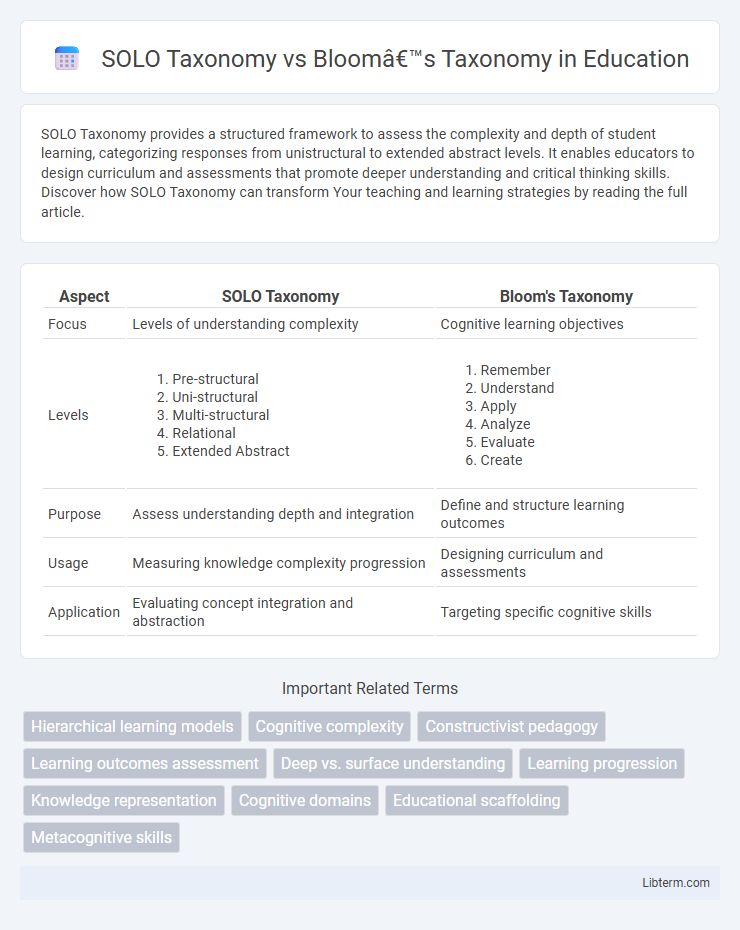SOLO Taxonomy provides a structured framework to assess the complexity and depth of student learning, categorizing responses from unistructural to extended abstract levels. It enables educators to design curriculum and assessments that promote deeper understanding and critical thinking skills. Discover how SOLO Taxonomy can transform Your teaching and learning strategies by reading the full article.
Table of Comparison
| Aspect | SOLO Taxonomy | Bloom's Taxonomy |
|---|---|---|
| Focus | Levels of understanding complexity | Cognitive learning objectives |
| Levels |
|
|
| Purpose | Assess understanding depth and integration | Define and structure learning outcomes |
| Usage | Measuring knowledge complexity progression | Designing curriculum and assessments |
| Application | Evaluating concept integration and abstraction | Targeting specific cognitive skills |
Introduction to Learning Taxonomies
SOLO Taxonomy classifies learning outcomes based on the complexity of student responses, ranging from unistructural to extended abstract levels, emphasizing depth of understanding. Bloom's Taxonomy organizes cognitive skills hierarchically from remembering to creating, focusing on the progression of intellectual abilities. Both frameworks serve as essential tools for educators to design curriculum and assess learning by targeting different cognitive dimensions and levels of mastery.
Overview of SOLO Taxonomy
The SOLO Taxonomy categorizes learning outcomes based on the complexity of students' understanding, progressing through five levels: pre-structural, uni-structural, multi-structural, relational, and extended abstract. Each level represents a deeper and more integrated comprehension of a subject, enabling educators to assess and develop cognitive skills beyond mere content recall. This taxonomy emphasizes qualitative differences in learning and provides a clear framework for evaluating the depth and coherence of student responses.
Overview of Bloom’s Taxonomy
Bloom's Taxonomy categorizes cognitive skills into six levels: Remembering, Understanding, Applying, Analyzing, Evaluating, and Creating, which progress from basic recall to higher-order thinking. It serves as a foundational framework for educators to design curriculum objectives, assessments, and instructional strategies that promote intellectual growth. Developed by Benjamin Bloom in 1956 and later revised in 2001, the taxonomy remains widely used to enhance learning outcomes and cognitive development.
Key Differences Between SOLO and Bloom’s Taxonomies
SOLO Taxonomy emphasizes levels of understanding from surface to deep learning, categorized into five hierarchical stages: pre-structural, uni-structural, multi-structural, relational, and extended abstract. Bloom's Taxonomy classifies cognitive skills into six levels: remembering, understanding, applying, analyzing, evaluating, and creating, focusing on specific cognitive processes. Unlike Bloom's linear progression of intellectual skills, SOLO assesses the quality and complexity of student responses to measure understanding depth.
Core Principles Behind Each Taxonomy
SOLO Taxonomy focuses on the structural complexity of student responses, progressing from pre-structural to extended abstract levels, emphasizing the quality of understanding rather than quantity. Bloom's Taxonomy categorizes cognitive skills into hierarchical levels--remembering, understanding, applying, analyzing, evaluating, and creating--highlighting progressive mastery of cognitive functions. Both taxonomies prioritize cognitive development but differ in approach: SOLO frames learning in terms of depth and complexity, while Bloom's emphasizes the breadth and type of cognitive skills.
Applications in the Classroom
SOLO Taxonomy structures learning outcomes with a focus on the complexity of student responses, guiding educators to design activities that progressively deepen understanding from unistructural to extended abstract levels. Bloom's Taxonomy categorizes cognitive skills into hierarchical levels from remembering to creating, which helps teachers create lesson plans targeting specific cognitive objectives through recall, application, and higher-order thinking tasks. Both frameworks enhance classroom applications by enabling tailored assessments and instructional strategies that foster critical thinking, problem-solving, and meaningful knowledge construction.
Advantages of SOLO Taxonomy
SOLO Taxonomy offers a clear, hierarchical structure that enhances student understanding by categorizing learning outcomes from surface to deep levels, making assessment more precise and reliable. It promotes deeper cognitive engagement through its five levels, which support progressive thinking and meaningful knowledge integration beyond simple recall or comprehension as seen in Bloom's Taxonomy. SOLO's emphasis on outcome quality aids educators in identifying specific areas for student improvement, facilitating targeted teaching strategies and personalized learning experiences.
Strengths of Bloom’s Taxonomy
Bloom's Taxonomy excels in providing a clear hierarchical structure for categorizing cognitive skills, ranging from basic knowledge recall to complex analytical and evaluative thinking. Its widespread adoption in educational settings supports curriculum design and assessment by enabling educators to target and measure specific cognitive objectives effectively. The taxonomy's simplicity and familiarity make it a practical tool for scaffolding learning and promoting higher-order thinking skills.
Choosing the Right Framework for Learning Assessment
Choosing the right framework for learning assessment depends on the desired depth and clarity of student understanding; SOLO Taxonomy excels in mapping the complexity of student responses from surface to deep learning, whereas Bloom's Taxonomy categorizes cognitive skills hierarchically from basic recall to higher-order thinking. SOLO provides a structured model for assessing the quality of learning outcomes through five levels: pre-structural, uni-structural, multi-structural, relational, and extended abstract, offering detailed feedback on student progression. Bloom's framework focuses on classifying learning objectives into cognitive domains such as remembering, understanding, applying, analyzing, evaluating, and creating, making it particularly effective for curriculum design and aligning assessments with learning goals.
Final Thoughts: Integrating SOLO and Bloom’s Approaches
Integrating SOLO Taxonomy with Bloom's Taxonomy enhances cognitive skill development by combining SOLO's focus on levels of understanding with Bloom's hierarchical classification of thinking skills. This fusion allows educators to design more comprehensive assessments that measure both the depth and complexity of student learning outcomes. Adopting both frameworks supports a balanced approach to fostering critical thinking, creativity, and knowledge mastery in diverse educational settings.
SOLO Taxonomy Infographic

 libterm.com
libterm.com